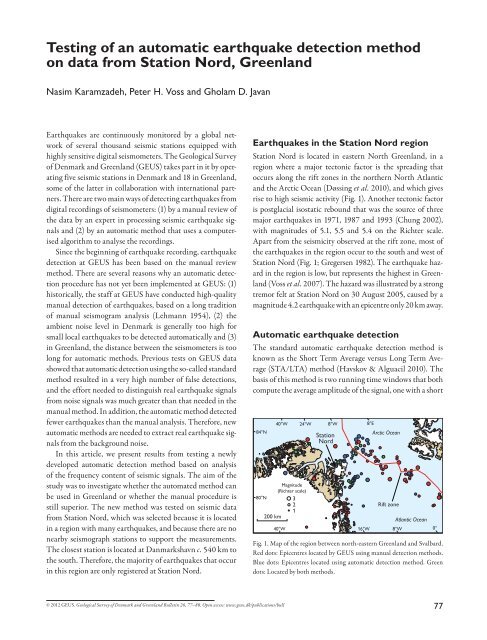Geological Survey of Denmark and Greenland Bulletin 26 ... - Geus
Geological Survey of Denmark and Greenland Bulletin 26 ... - Geus
Geological Survey of Denmark and Greenland Bulletin 26 ... - Geus
You also want an ePaper? Increase the reach of your titles
YUMPU automatically turns print PDFs into web optimized ePapers that Google loves.
Testing <strong>of</strong> an automatic earthquake detection method<br />
on data from Station Nord, Greenl<strong>and</strong><br />
Nasim Karamzadeh, Peter H. Voss <strong>and</strong> Gholam D. Javan<br />
Earthquakes are continuously monitored by a global network<br />
<strong>of</strong> several thous<strong>and</strong> seismic stations equipped with<br />
highly sensitive digital seismometers. The <strong>Geological</strong> <strong>Survey</strong><br />
<strong>of</strong> <strong>Denmark</strong> <strong>and</strong> Greenl<strong>and</strong> (GEUS) takes part in it by operating<br />
five seismic stations in <strong>Denmark</strong> <strong>and</strong> 18 in Greenl<strong>and</strong>,<br />
some <strong>of</strong> the latter in collaboration with international partners.<br />
There are two main ways <strong>of</strong> detecting earthquakes from<br />
digital recordings <strong>of</strong> seismometers: (1) by a manual review <strong>of</strong><br />
the data by an expert in processing seismic earthquake signals<br />
<strong>and</strong> (2) by an automatic method that uses a computerised<br />
algorithm to analyse the recordings.<br />
Since the beginning <strong>of</strong> earthquake recording, earthquake<br />
detection at GEUS has been based on the manual review<br />
method. There are several reasons why an automatic detection<br />
procedure has not yet been implemented at GEUS: (1)<br />
historically, the staff at GEUS have conducted high-quality<br />
manual detection <strong>of</strong> earthquakes, based on a long tradition<br />
<strong>of</strong> manual seismogram analysis (Lehmann 1954), (2) the<br />
ambient noise level in <strong>Denmark</strong> is generally too high for<br />
small local earthquakes to be detected automatically <strong>and</strong> (3)<br />
in Greenl<strong>and</strong>, the distance between the seismometers is too<br />
long for automatic methods. Previous tests on GEUS data<br />
showed that automatic detection using the so-called st<strong>and</strong>ard<br />
method resulted in a very high number <strong>of</strong> false detections,<br />
<strong>and</strong> the effort needed to distinguish real earthquake signals<br />
from noise signals was much greater than that needed in the<br />
manual method. In addition, the automatic method detected<br />
fewer earthquakes than the manual analysis. Therefore, new<br />
automatic methods are needed to extract real earthquake signals<br />
from the background noise.<br />
In this article, we present results from testing a newly<br />
developed automatic detection method based on analysis<br />
<strong>of</strong> the frequency content <strong>of</strong> seismic signals. The aim <strong>of</strong> the<br />
study was to investigate whether the automated method can<br />
be used in Greenl<strong>and</strong> or whether the manual procedure is<br />
still superior. The new method was tested on seismic data<br />
from Station Nord, which was selected because it is located<br />
in a region with many earthquakes, <strong>and</strong> because there are no<br />
nearby seismograph stations to support the measurements.<br />
The closest station is located at Danmarkshavn c. 540 km to<br />
the south. Therefore, the majority <strong>of</strong> earthquakes that occur<br />
in this region are only registered at Station Nord.<br />
Earthquakes in the Station Nord region<br />
Station Nord is located in eastern North Greenl<strong>and</strong>, in a<br />
region where a major tectonic factor is the spreading that<br />
occurs along the rift zones in the northern North Atlantic<br />
<strong>and</strong> the Arctic Ocean (Døssing et al. 2010), <strong>and</strong> which gives<br />
rise to high seismic activity (Fig. 1). Another tectonic factor<br />
is postglacial isostatic rebound that was the source <strong>of</strong> three<br />
major earthquakes in 1971, 1987 <strong>and</strong> 1993 (Chung 2002),<br />
with magnitudes <strong>of</strong> 5.1, 5.5 <strong>and</strong> 5.4 on the Richter scale.<br />
Apart from the seismicity observed at the rift zone, most <strong>of</strong><br />
the earthquakes in the region occur to the south <strong>and</strong> west <strong>of</strong><br />
Station Nord (Fig. 1; Gregersen 1982). The earthquake hazard<br />
in the region is low, but represents the highest in Greenl<strong>and</strong><br />
(Voss et al. 2007). The hazard was illustrated by a strong<br />
tremor felt at Station Nord on 30 August 2005, caused by a<br />
magnitude 4.2 earthquake with an epicentre only 20 km away.<br />
Automatic earthquake detection<br />
The st<strong>and</strong>ard automatic earthquake detection method is<br />
known as the Short Term Average versus Long Term Average<br />
(STA/LTA) method (Havskov & Alguacil 2010). The<br />
basis <strong>of</strong> this method is two running time windows that both<br />
compute the average amplitude <strong>of</strong> the signal, one with a short<br />
84°N<br />
40°W 24°W 8°W 8°E<br />
Station<br />
Arctic Ocean<br />
Nord<br />
Magnitude<br />
(Richter scale)<br />
80°N 3<br />
2<br />
Rift zone<br />
1<br />
200 km<br />
Atlantic Ocean<br />
40°W 16°W 8°W<br />
Fig. 1. Map <strong>of</strong> the region between north-eastern Greenl<strong>and</strong> <strong>and</strong> Svalbard.<br />
Red dots: Epicentres located by GEUS using manual detection methods.<br />
Blue dots: Epicentres located using automatic detection method. Green<br />
dots: Located by both methods.<br />
0°<br />
© 2012 GEUS. <strong>Geological</strong> <strong>Survey</strong> <strong>of</strong> <strong>Denmark</strong> <strong>and</strong> Greenl<strong>and</strong> <strong>Bulletin</strong> <strong>26</strong>, 77–80. Open access: www.geus.dk/publications/bull<br />
77

















